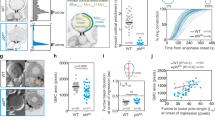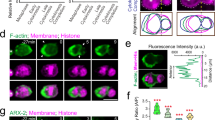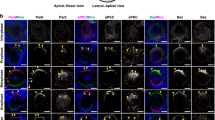Abstract
During development, the establishment of cell polarity is important for cells to undergo asymmetric cell divisions that give rise to diverse cell types. In C. elegans embryos, cues from the centrosome trigger the cortical flow of an actomyosin network, leading to the formation of anterior–posterior polarity1. However, its precise mechanism is poorly understood. Here, we show that small GTPases have sequential and crucial functions in this process. ECT-2, a potential guanine nucleotide-exchange factor (GEF)2 for RHO-1, was uniformly distributed at the cortex before polarization, but was excluded from the posterior cortex by the polarity cue from the centrosomes. This local exclusion of ECT-2 led to an asymmetric RHO-1 distribution, which generated a cortical flow of the actomyosin that translocated PAR proteins3 and CDC-42 (Refs 4, 5) to the anterior cortex. Polarized CDC-42 was, in turn, involved in maintaining the established anterior-cortical domains. Our results suggest that a local change in the function of ECT-2 and RHO-1 links the centrosomal polarity cue with the polarization of the cell cortex.
This is a preview of subscription content, access via your institution
Access options
Subscribe to this journal
Receive 12 print issues and online access
$209.00 per year
only $17.42 per issue
Buy this article
- Purchase on Springer Link
- Instant access to full article PDF
Prices may be subject to local taxes which are calculated during checkout





Similar content being viewed by others
References
Munro, E., Nance, J. & Priess, J. R. Cortical flows powered by asymmetrical contraction transport PAR proteins to establish and maintain anterior-posterior polarity in the early C. elegans embryo. Dev. Cell 7, 413–424 (2004).
Morita, K., Hirono, K. & Han, M. The Caenorhabditis elegans ect-2 RhoGEF gene regulates cytokinesis and migration of epidermal P cells. EMBO Rep. 6, 1163–1168 (2005).
Kemphues, K. PARsing embryonic polarity. Cell 12, 345–348 (2000).
Gotta, M., Abraham, M. C. & Ahringer, J. CDC-42 controls early cell polarity and spindle orientation in C. elegans. Curr. Biol. 11, 482–488 (2001).
Kay, A. J. & Hunter, C. P. CDC-42 regulates PAR protein localization and function to control cellular and embryonic polarity in C. elegans. Curr. Biol. 11, 474–481 (2001).
Cowan, C. R. & Hyman, A. A. Asymmetric cell division in C. elegans: cortical polarity and spindle positioning. Annu. Rev. Cell Dev. Biol. 20, 427–453 (2004).
Cowan, C. R. & Hyman, A. A. Centrosomes direct cell polarity independently of microtubule assembly in C. elegans embryos. Nature 431, 92–96 (2004).
Wallenfang, M. R. & Seydoux, G. Polarization of the anterior-posterior axis of C. elegans is a microtubule-directed process. Nature 408, 89–92 (2000).
Cuenca, A. A., Schetter, A., Aceto, D., Kemphues, K. J. & Seydoux, G. Polarization of the C. elegans zygote proceeds via distinct establishment and maintenance phases. Development 130, 1255–1265 (2003).
Guo, S. & Kemphues, K. J. A non-muscle myosin required for embryonic polarity in Caenorhabditis elegans. Nature 382, 455–458 (1996).
Hill, D. P. & Strome, S. An analysis of the role of microfilaments in the establishment and maintenance of asymmetry in Caenorhabditis elegans zygotes. Dev. Biol. 125, 75–84 (1988).
Shelton, C. A., Carter, J. C., Ellis, G. C. & Bowerman, B. The nonmuscle myosin regulatory light chain gene mlc-4 is required for cytokinesis, anterior-posterior polarity, and body morphology during Caenorhabditis elegans embryogenesis. J. Cell Biol. 146, 439–451 (1999).
Severson, A. F. & Bowerman, B. Myosin and the PAR proteins polarize microfilament-dependent forces that shape and position mitotic spindles in Caenorhabditis elegans. J. Cell Biol. 161, 21–26 (2003).
Hall, A. Rho GTPases and the actin cytoskeleton. Science 279, 509–514 (1998).
Motegi, F., Velarde, N. V., Piano, F. & Sugimoto, A. Two phases of astral microtubule activity during cytokinesis in C. elegans embryos. Dev. Cell 10, 509–520 (2006).
Jantsch-Plunger, V. et al. CYK-4: A Rho family GTPase activating protein (GAP) required for central spindle formation and cytokinesis. J. Cell Biol. 149, 1391–1404 (2000).
Dechant, R. & Glotzer, M. Centrosome separation and central spindle assembly act in redundant pathways that regulate microtubule density and trigger cleavage furrow formation. Dev. Cell 4, 333–344 (2003).
Audhya, A. et al. A complex containing the Sm protein CAR-1 and the RNA helicase CGH-1 is required for embryonic cytokinesis in Caenorhabditis elegans. J. Cell Biol. 171, 267–279 (2005).
Hamill, D. R., Severson, A. F., Carter, J. C. & Bowerman, B. Centrosome maturation and mitotic spindle assembly in C. elegans require SPD-5, a protein with multiple coiled-coil domains. Dev. Cell 3, 673–684 (2002).
Nishimura, Y. & Yonemura, S. Centralspindlin regulates ECT2 and RhoA accumulation at the equatorial cortex during cytokinesis. J. Cell Sci. 119, 104–114 (2006).
Yuce, O., Piekny, A. & Glotzer, M. An ECT2-centralspindlin complex regulates the localization and function of RhoA. J. Cell Biol. 170, 571–582 (2005).
Hird, S. N. & White, J. G. Cortical and cytoplasmic flow polarity in early embryonic cells of Caenorhabditis elegans. J. Cell Biol. 121, 1343–1355 (1993).
Etienne-Manneville, S. Cdc42 — the centre of polarity. J. Cell Sci. 117, 1291–1300 (2004).
Joberty, G., Petersen, C., Gao, L. & Macara, I. G. The cell-polarity protein Par6 links Par3 and atypical protein kinase C to Cdc42. Nature Cell Biol. 2, 531–539 (2000).
Praitis, V., Casey, E., Collar, D. & Austin, J. Creation of low-copy integrated transgenic lines in Caenorhabditis elegans. Genetics 157, 1217–1226 (2001).
Maeda, I., Kohara, Y., Yamamoto, M. & Sugimoto, A. Large-scale analysis of gene function in Caenorhabditis elegans by high-throughput RNAi. Curr. Biol. 11, 171–176 (2001).
Sumiyoshi, E., Sugimoto, A. & Yamamoto, M. Protein phosphatase 4 is required for centrosome maturation in mitosis and sperm meiosis in C. elegans. J. Cell Sci. 115, 1403–1410 (2002).
Edger, L. G. Blastmere culture and analysis. Methods Cell Biol. 48, 303–321 (1995).
Acknowledgements
We thank N.V. Velarde and F. Piano for kindly providing the strain expressing GFP–moe and for sharing information before publication; F. Matsuzaki for suggestions and thoughtful comments on the manuscript; and G. Seydoux, D. Kiehart, K. Kemphues, A. Audhya and Y. Kohara for their generous gifts of reagents. We also thank Y. Kodama for the initial characterization of the ect-2 gene and all members of our laboratories for helpful discussions. Some of the worm strains used in this study were provided by the Caenorhabditis Genetics Center, which is funded by the National Institutes of Health (NIH) National Center for Research Resources. This work was supported by a Grant-in-Aid for Scientific Research on Priority Areas 'Systems Genomics' (A.S.) and a Grant-in-Aid for Young Scientists B (F.M.) from the Ministry of Education, Culture, Sports, Science and Technology of Japan. F.M. was supported by the Special Postdoctoral Researchers Program of RIKEN.
Author information
Authors and Affiliations
Contributions
F.M. designed and performed the experiments. F.M. and A.S. performed the data analysis and wrote the paper. A.S. was responsible for project planning and guidance.
Corresponding author
Ethics declarations
Competing interests
The authors declare no competing financial interests.
Supplementary information
Supplementary Information
Supplementary Figures S1, S2, S3 and Supplementary Methods (PDF 591 kb)
Rights and permissions
About this article
Cite this article
Motegi, F., Sugimoto, A. Sequential functioning of the ECT-2 RhoGEF, RHO-1 and CDC-42 establishes cell polarity in Caenorhabditis elegans embryos. Nat Cell Biol 8, 978–985 (2006). https://doi.org/10.1038/ncb1459
Received:
Accepted:
Published:
Issue Date:
DOI: https://doi.org/10.1038/ncb1459
This article is cited by
-
Intracellular tension sensor reveals mechanical anisotropy of the actin cytoskeleton
Nature Communications (2023)
-
Guiding self-organized pattern formation in cell polarity establishment
Nature Physics (2019)
-
Coupling changes in cell shape to chromosome segregation
Nature Reviews Molecular Cell Biology (2016)
-
Small GTPase CDC-42 promotes apoptotic cell corpse clearance in response to PAT-2 and CED-1 in C. elegans
Cell Death & Differentiation (2014)
-
Actomyosin Regulation and Symmetry Breaking in a Model of Polarization in the Early Caenorhabditis elegans Embryo
Bulletin of Mathematical Biology (2014)



